height MAZDA MODEL MAZDASPEED 3 2007 Owners Manual (in English)
[x] Cancel search | Manufacturer: MAZDA, Model Year: 2007, Model line: MODEL MAZDASPEED 3, Model: MAZDA MODEL MAZDASPEED 3 2007Pages: 402, PDF Size: 7.08 MB
Page 18 of 402
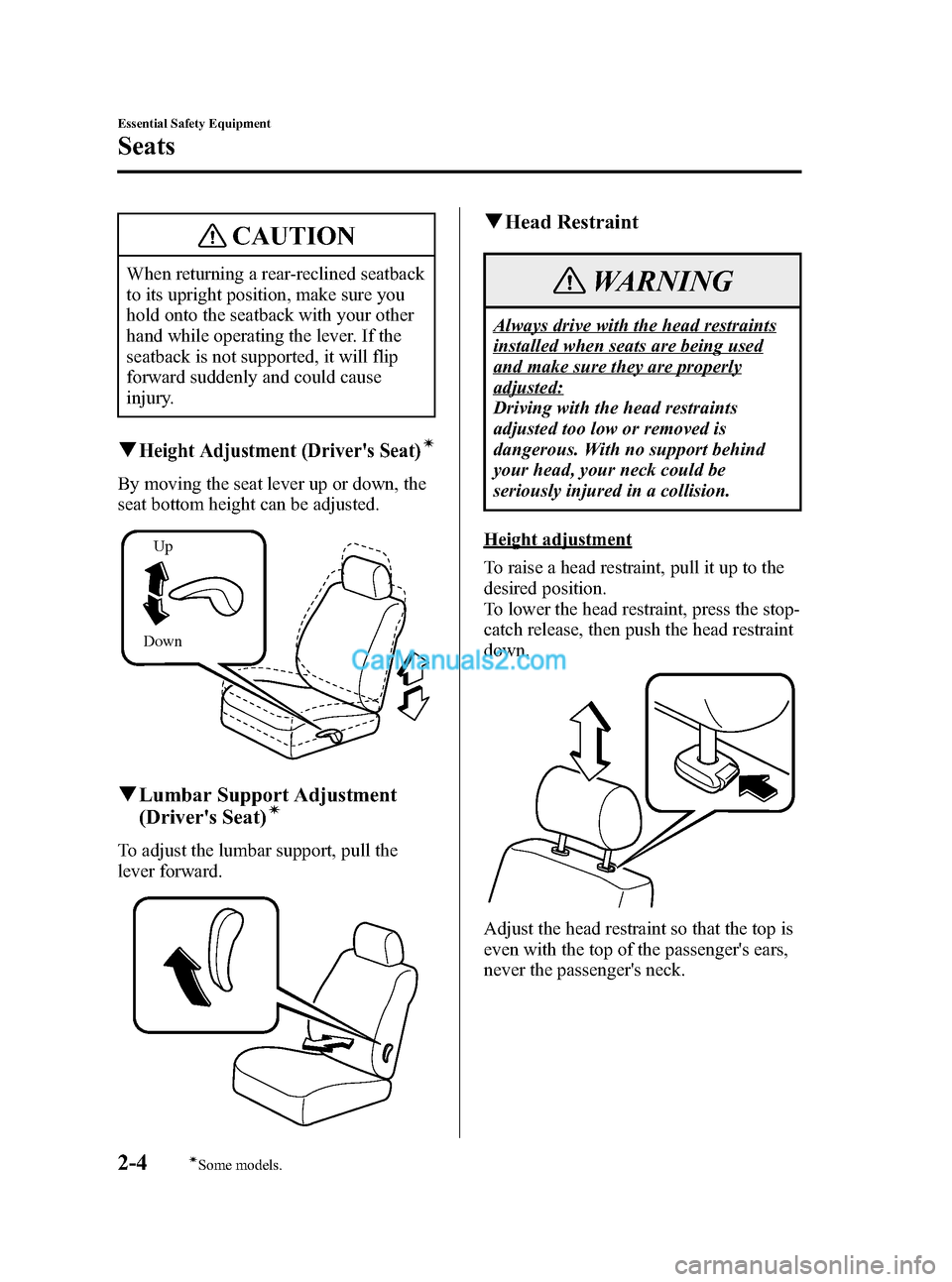
Black plate (18,1)
CAUTION
When returning a rear-reclined seatback
to its upright position, make sure you
hold onto the seatback with your other
hand while operating the lever. If the
seatback is not supported, it will flip
forward suddenly and could cause
injury.
qHeight Adjustment (Driver's Seat)í
By moving the seat lever up or down, the
seat bottom height can be adjusted.
DownUp
qLumbar Support Adjustment
(Driver's Seat)í
To adjust the lumbar support, pull the
lever forward.
qHead Restraint
WARNING
Always drive with the head restraints
installed when seats are being used
and make sure they are properly
adjusted:
Driving with the head restraints
adjusted too low or removed is
dangerous. With no support behind
your head, your neck could be
seriously injured in a collision.
Height adjustment
To raise a head restraint, pull it up to the
desired position.
To lower the head restraint, press the stop-
catch release, then push the head restraint
down.
Adjust the head restraint so that the top is
even with the top of the passenger's ears,
never the passenger's neck.
2-4
Essential Safety Equipment
íSome models.
Seats
Mazda3_8V66-EA-06F_Edition3 Page18
Wednesday, August 23 2006 11:18 AM
Form No.8V66-EA-06F
Page 22 of 402
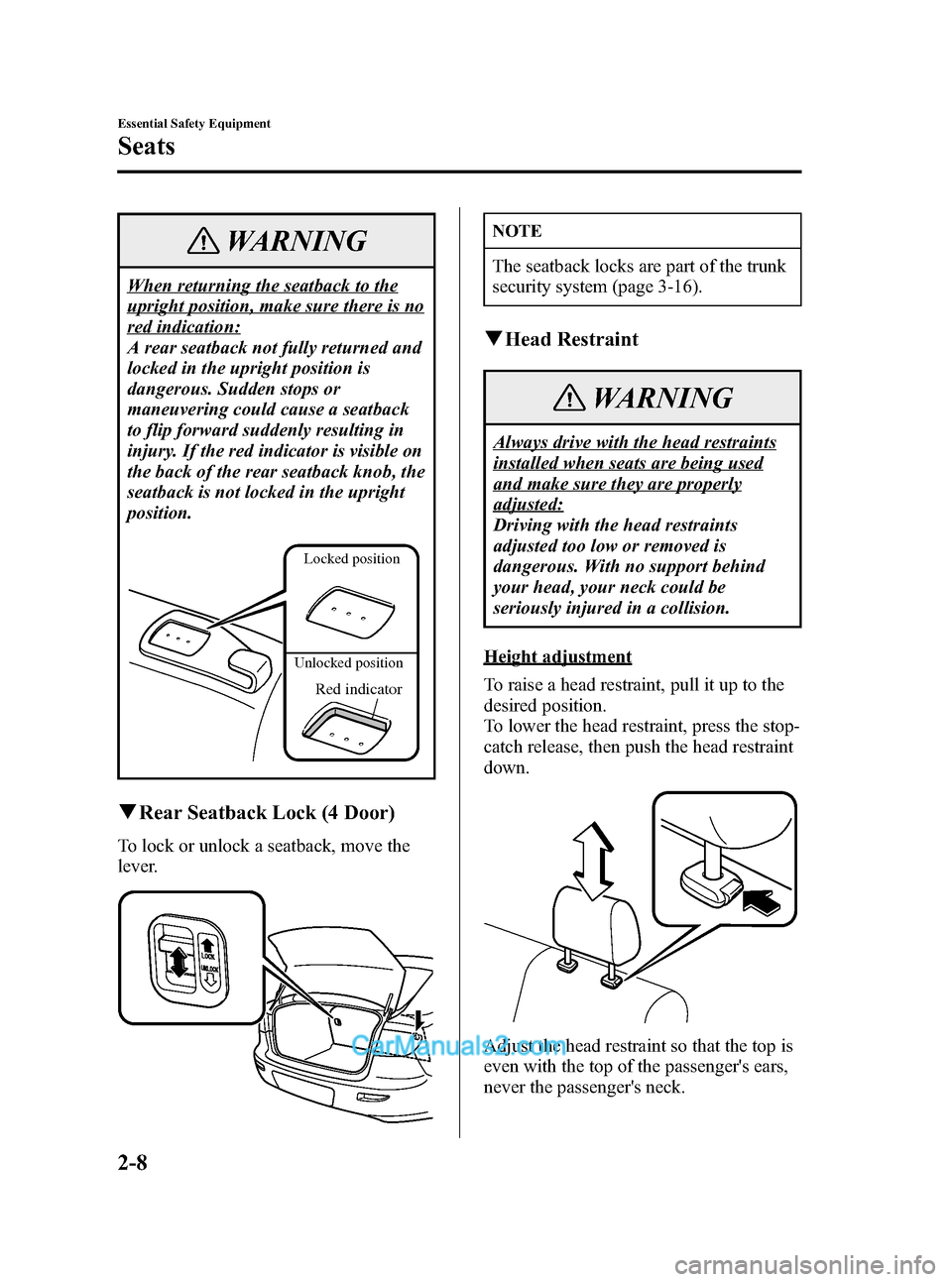
Black plate (22,1)
WARNING
When returning the seatback to the
upright position, make sure there is no
red indication:
A rear seatback not fully returned and
locked in the upright position is
dangerous. Sudden stops or
maneuvering could cause a seatback
to flip forward suddenly resulting in
injury. If the red indicator is visible on
the back of the rear seatback knob, the
seatback is not locked in the upright
position.
Locked position
Unlocked position
Red indicator
qRear Seatback Lock (4 Door)
To lock or unlock a seatback, move the
lever.
NOTE
The seatback locks are part of the trunk
security system (page 3-16).
qHead Restraint
WARNING
Always drive with the head restraints
installed when seats are being used
and make sure they are properly
adjusted:
Driving with the head restraints
adjusted too low or removed is
dangerous. With no support behind
your head, your neck could be
seriously injured in a collision.
Height adjustment
To raise a head restraint, pull it up to the
desired position.
To lower the head restraint, press the stop-
catch release, then push the head restraint
down.
Adjust the head restraint so that the top is
even with the top of the passenger's ears,
never the passenger's neck.
2-8
Essential Safety Equipment
Seats
Mazda3_8V66-EA-06F_Edition3 Page22
Wednesday, August 23 2006 11:18 AM
Form No.8V66-EA-06F
Page 28 of 402
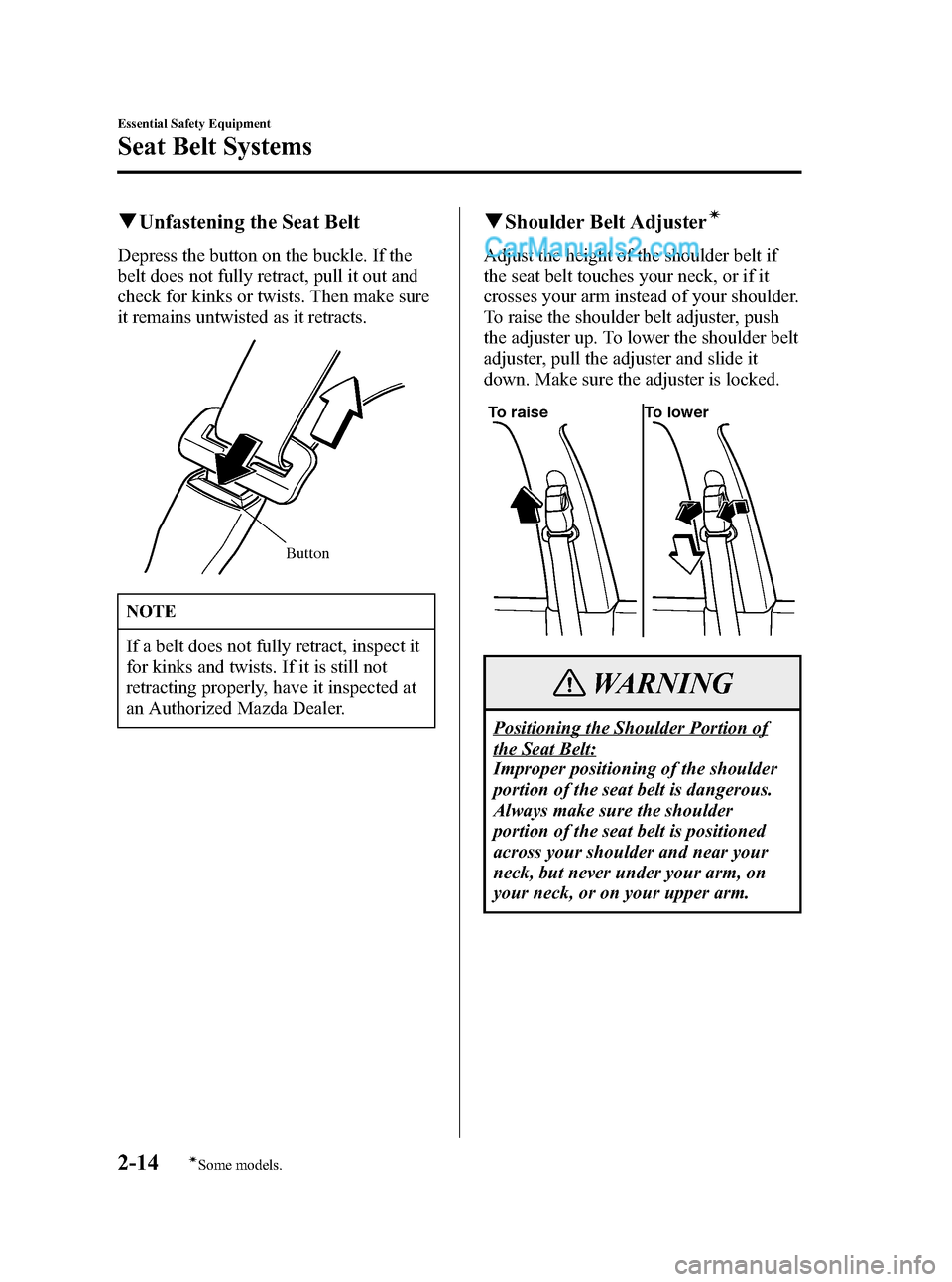
Black plate (28,1)
qUnfastening the Seat Belt
Depress the button on the buckle. If the
belt does not fully retract, pull it out and
check for kinks or twists. Then make sure
it remains untwisted as it retracts.
Button
NOTE
If a belt does not fully retract, inspect it
for kinks and twists. If it is still not
retracting properly, have it inspected at
an Authorized Mazda Dealer.
qShoulder Belt Adjusterí
Adjust the height of the shoulder belt if
the seat belt touches your neck, or if it
crosses your arm instead of your shoulder.
To raise the shoulder belt adjuster, push
the adjuster up. To lower the shoulder belt
adjuster, pull the adjuster and slide it
down. Make sure the adjuster is locked.
To raise To lower
WARNING
Positioning the Shoulder Portion of
the Seat Belt:
Improper positioning of the shoulder
portion of the seat belt is dangerous.
Always make sure the shoulder
portion of the seat belt is positioned
across your shoulder and near your
neck, but never under your arm, on
your neck, or on your upper arm.
2-14
Essential Safety Equipment
íSome models.
Seat Belt Systems
Mazda3_8V66-EA-06F_Edition3 Page28
Wednesday, August 23 2006 11:18 AM
Form No.8V66-EA-06F
Page 58 of 402
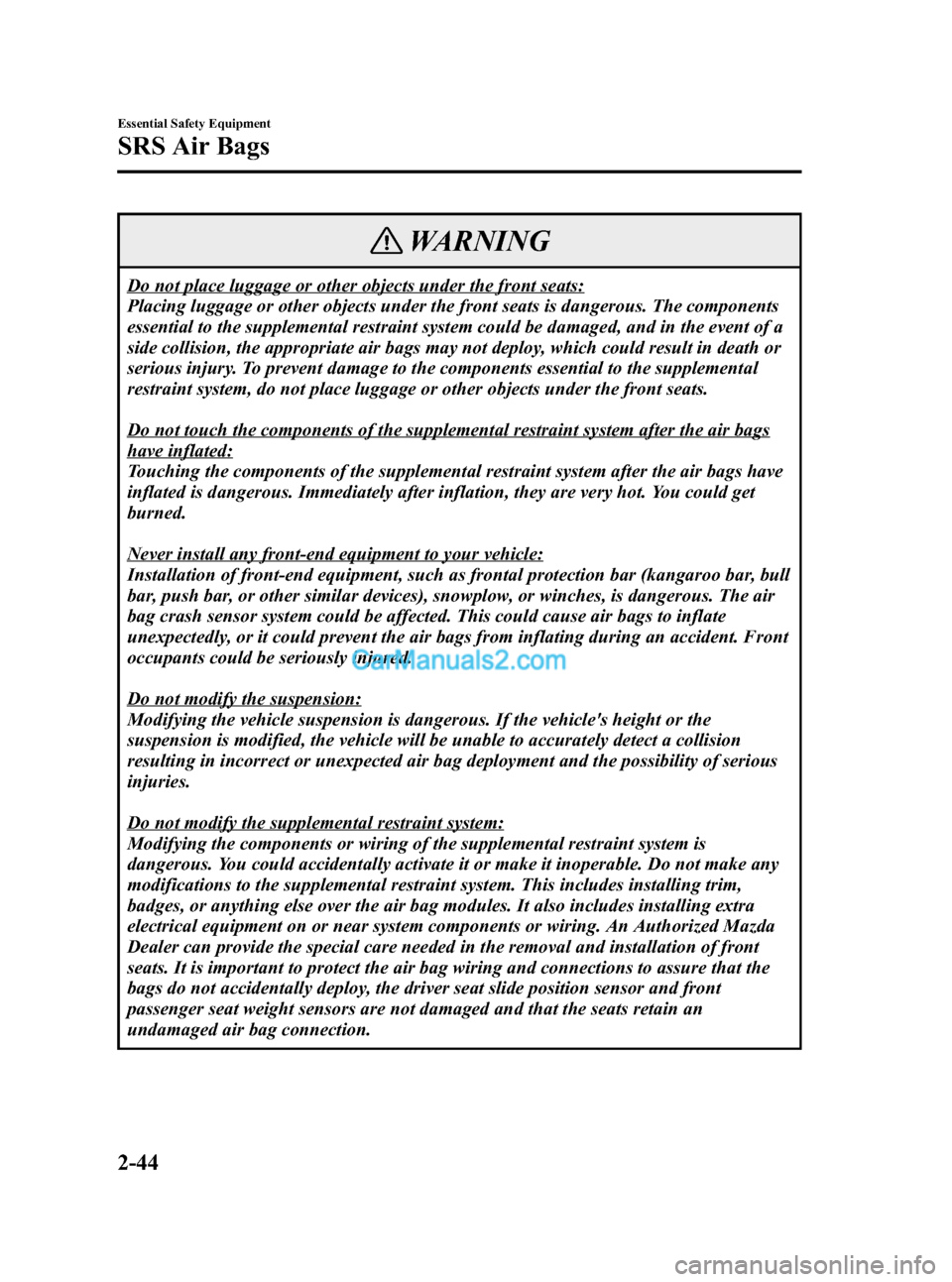
Black plate (58,1)
WARNING
Do not place luggage or other objects under the front seats:
Placing luggage or other objects under the front seats is dangerous. The components
essential to the supplemental restraint system could be damaged, and in the event of a
side collision, the appropriate air bags may not deploy, which could result in death or
serious injury. To prevent damage to the components essential to the supplemental
restraint system, do not place luggage or other objects under the front seats.
Do not touch the components of the supplemental restraint system after the air bags
have inflated:
Touching the components of the supplemental restraint system after the air bags have
inflated is dangerous. Immediately after inflation, they are very hot. You could get
burned.
Never install any front-end equipment to your vehicle:
Installation of front-end equipment, such as frontal protection bar (kangaroo bar, bull
bar, push bar, or other similar devices), snowplow, or winches, is dangerous. The air
bag crash sensor system could be affected. This could cause air bags to inflate
unexpectedly, or it could prevent the air bags from inflating during an accident. Front
occupants could be seriously injured.
Do not modify the suspension:
Modifying the vehicle suspension is dangerous. If the vehicle's height or the
suspension is modified, the vehicle will be unable to accurately detect a collision
resulting in incorrect or unexpected air bag deployment and the possibility of serious
injuries.
Do not modify the supplemental restraint system:
Modifying the components or wiring of the supplemental restraint system is
dangerous. You could accidentally activate it or make it inoperable. Do not make any
modifications to the supplemental restraint system. This includes installing trim,
badges, or anything else over the air bag modules. It also includes installing extra
electrical equipment on or near system components or wiring. An Authorized Mazda
Dealer can provide the special care needed in the removal and installation of front
seats. It is important to protect the air bag wiring and connections to assure that the
bags do not accidentally deploy, the driver seat slide position sensor and front
passenger seat weight sensors are not damaged and that the seats retain an
undamaged air bag connection.
2-44
Essential Safety Equipment
SRS Air Bags
Mazda3_8V66-EA-06F_Edition3 Page58
Wednesday, August 23 2006 11:18 AM
Form No.8V66-EA-06F
Page 313 of 402
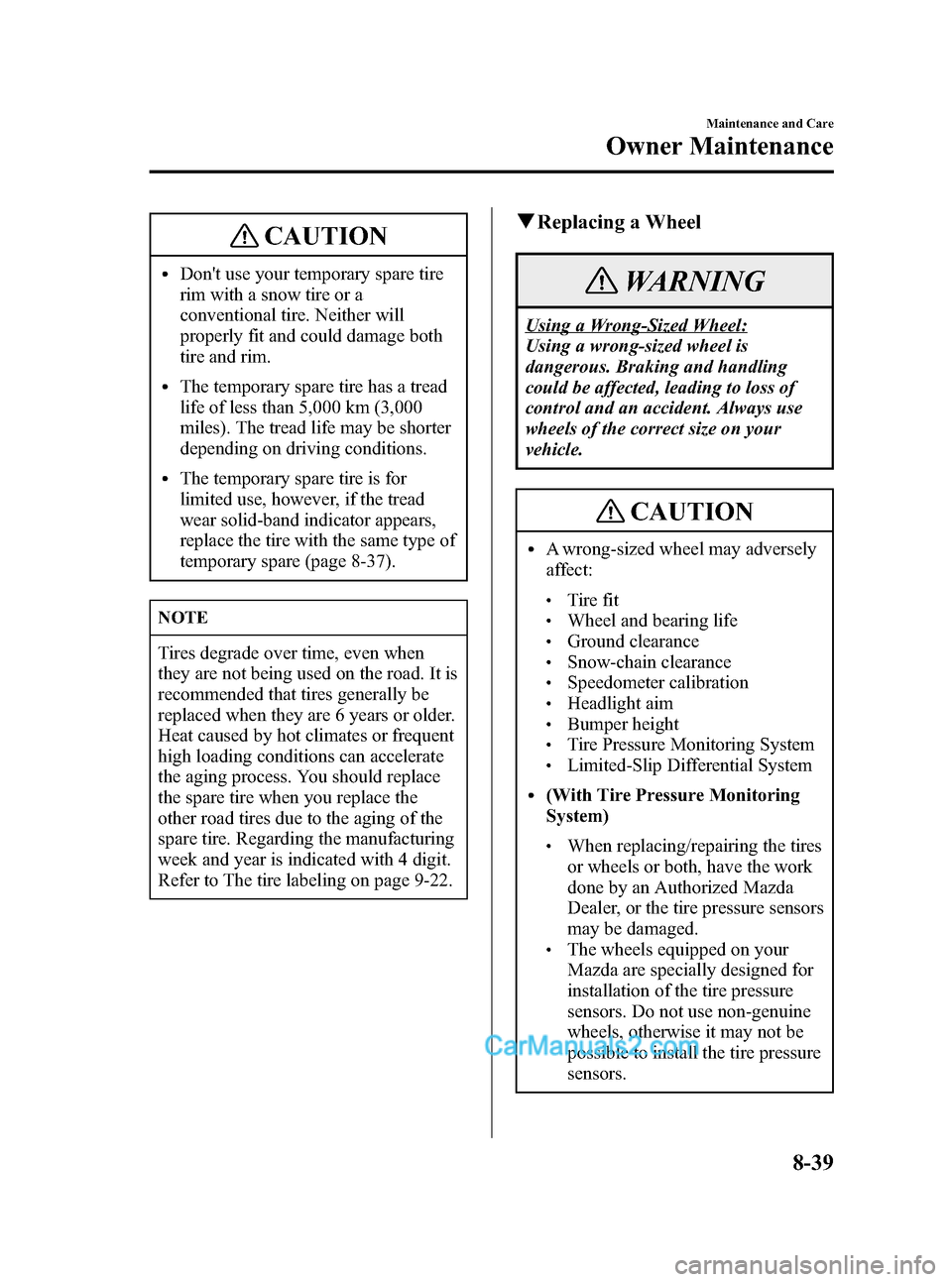
Black plate (313,1)
CAUTION
lDon't use your temporary spare tire
rim with a snow tire or a
conventional tire. Neither will
properly fit and could damage both
tire and rim.
lThe temporary spare tire has a tread
life of less than 5,000 km (3,000
miles). The tread life may be shorter
depending on driving conditions.
lThe temporary spare tire is for
limited use, however, if the tread
wear solid-band indicator appears,
replace the tire with the same type of
temporary spare (page 8-37).
NOTE
Tires degrade over time, even when
they are not being used on the road. It is
recommended that tires generally be
replaced when they are 6 years or older.
Heat caused by hot climates or frequent
high loading conditions can accelerate
the aging process. You should replace
the spare tire when you replace the
other road tires due to the aging of the
spare tire. Regarding the manufacturing
week and year is indicated with 4 digit.
Refer to The tire labeling on page 9-22.
qReplacing a Wheel
WARNING
Using a Wrong-Sized Wheel:
Using a wrong-sized wheel is
dangerous. Braking and handling
could be affected, leading to loss of
control and an accident. Always use
wheels of the correct size on your
vehicle.
CAUTION
lA wrong-sized wheel may adversely
affect:
lTire fitlWheel and bearing lifelGround clearancelSnow-chain clearancelSpeedometer calibrationlHeadlight aimlBumper heightlTire Pressure Monitoring SystemlLimited-Slip Differential System
l(With Tire Pressure Monitoring
System)
lWhen replacing/repairing the tires
or wheels or both, have the work
done by an Authorized Mazda
Dealer, or the tire pressure sensors
may be damaged.
lThe wheels equipped on your
Mazda are specially designed for
installation of the tire pressure
sensors. Do not use non-genuine
wheels, otherwise it may not be
possible to install the tire pressure
sensors.
Maintenance and Care
Owner Maintenance
8-39
Mazda3_8V66-EA-06F_Edition3 Page313
Wednesday, August 23 2006 11:21 AM
Form No.8V66-EA-06F
Page 362 of 402
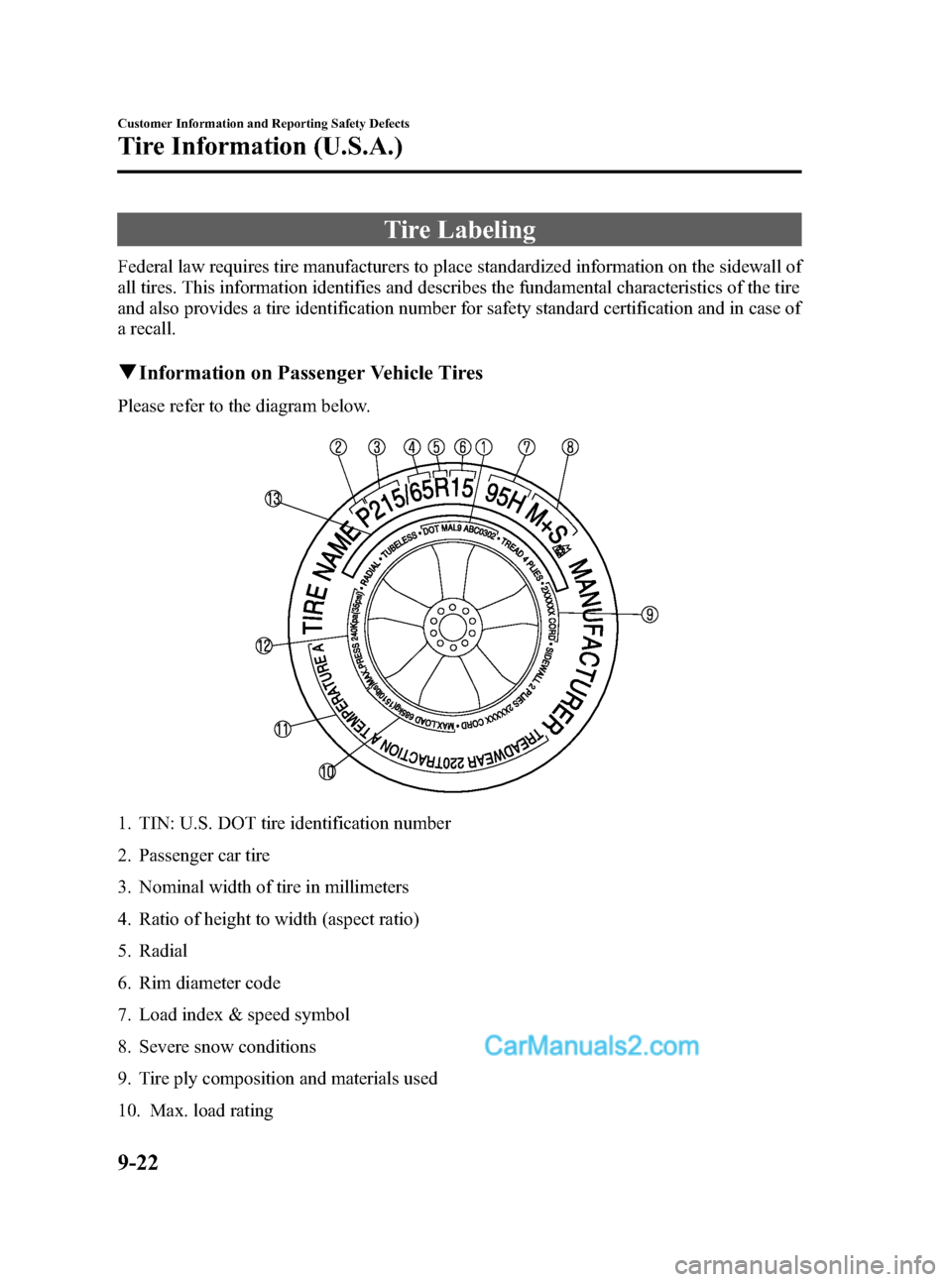
Black plate (362,1)
Tire Labeling
Federal law requires tire manufacturers to place standardized information on the sidewall of
all tires. This information identifies and describes the fundamental characteristics of the tire
and also provides a tire identification number for safety standard certification and in case of
a recall.
qInformation on Passenger Vehicle Tires
Please refer to the diagram below.
1. TIN: U.S. DOT tire identification number
2. Passenger car tire
3. Nominal width of tire in millimeters
4. Ratio of height to width (aspect ratio)
5. Radial
6. Rim diameter code
7. Load index & speed symbol
8. Severe snow conditions
9. Tire ply composition and materials used
10. Max. load rating
9-22
Customer Information and Reporting Safety Defects
Tire Information (U.S.A.)
Mazda3_8V66-EA-06F_Edition3 Page362
Wednesday, August 23 2006 11:22 AM
Form No.8V66-EA-06F
Page 363 of 402
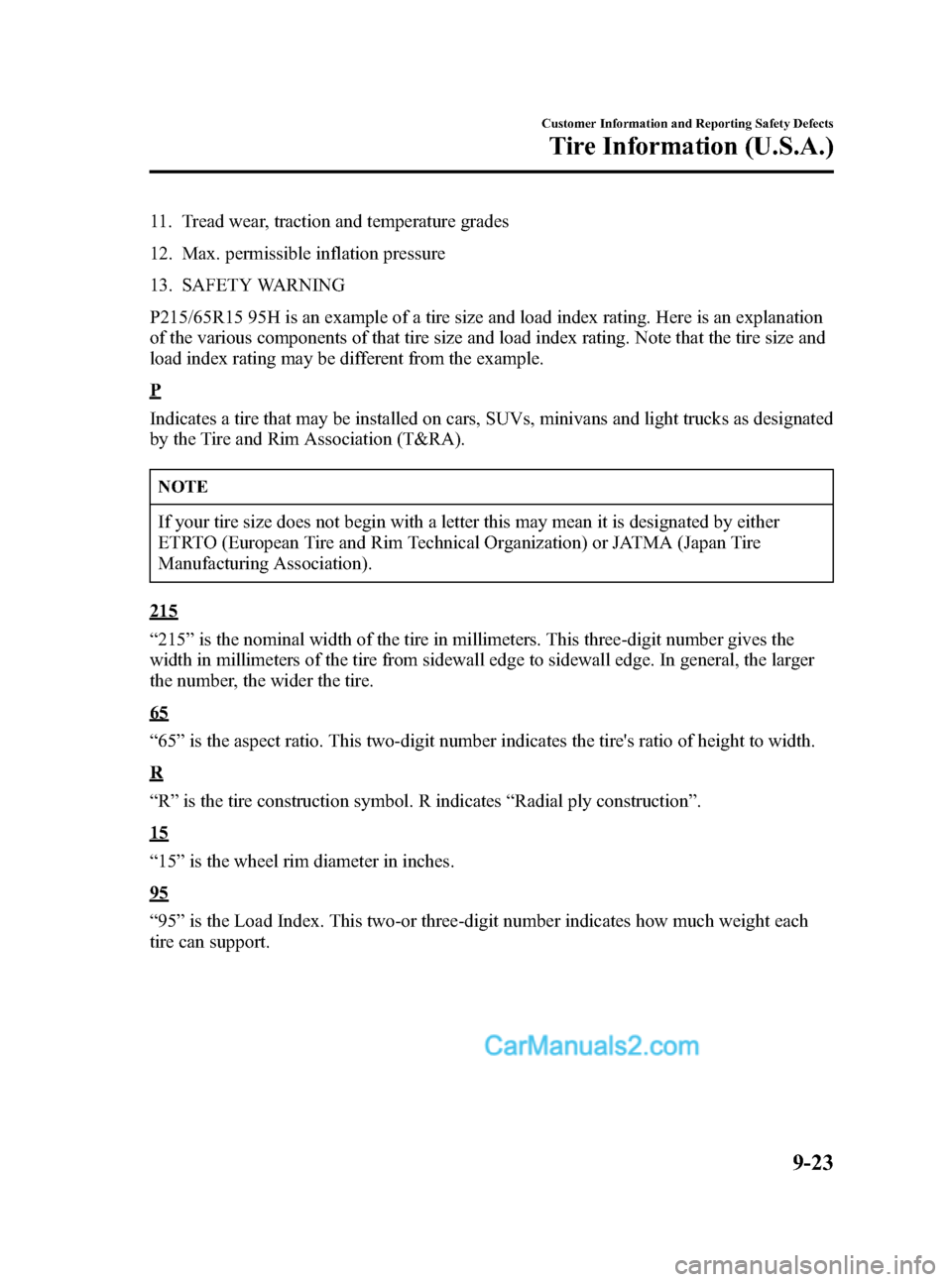
Black plate (363,1)
11. Tread wear, traction and temperature grades
12. Max. permissible inflation pressure
13. SAFETY WARNING
P215/65R15 95H is an example of a tire size and load index rating. Here is an explanation
of the various components of that tire size and load index rating. Note that the tire size and
load index rating may be different from the example.
P
Indicates a tire that may be installed on cars, SUVs, minivans and light trucks as designated
by the Tire and Rim Association (T&RA).
NOTE
If your tire size does not begin with a letter this may mean it is designated by either
ETRTO (European Tire and Rim Technical Organization) or JATMA (Japan Tire
Manufacturing Association).
215
“215”is the nominal width of the tire in millimeters. This three-digit number gives the
width in millimeters of the tire from sidewall edge to sidewall edge. In general, the larger
the number, the wider the tire.
65
“65”is the aspect ratio. This two-digit number indicates the tire's ratio of height to width.
R
“R”is the tire construction symbol. R indicates“Radial ply construction”.
15
“15”is the wheel rim diameter in inches.
95
“95”is the Load Index. This two-or three-digit number indicates how much weight each
tire can support.
Customer Information and Reporting Safety Defects
Tire Information (U.S.A.)
9-23
Mazda3_8V66-EA-06F_Edition3 Page363
Wednesday, August 23 2006 11:22 AM
Form No.8V66-EA-06F
Page 366 of 402

Black plate (366,1)
qInformation on Temporary Tires
Please refer to the diagram below.
1. Temporary tires
2. Nominal width of tire in millimeters
3. Ratio of height to width (aspect ratio)
4. Diagonal
5. Rim diameter code
6. Load index&speed symbol
T115/70D 16 90M is an example of a tire size and load index rating. Here is an explanation
of the various components of that tire size and load index rating. Note that the tire size and
load index rating may be different from the example.
T
Indicates a tire that may be installed on cars, SUVs, minivans and light trucks as designated
by the Tire and Rim Association (T&RA).
11 5
“115”is the nominal width of the tire in millimeters. This three-digit number gives the
width in millimeters of the tire from sidewall edge to sidewall edge. In general, the larger
the number, the wider the tire.
9-26
Customer Information and Reporting Safety Defects
Tire Information (U.S.A.)
Mazda3_8V66-EA-06F_Edition3 Page366
Wednesday, August 23 2006 11:22 AM
Form No.8V66-EA-06F
Page 367 of 402
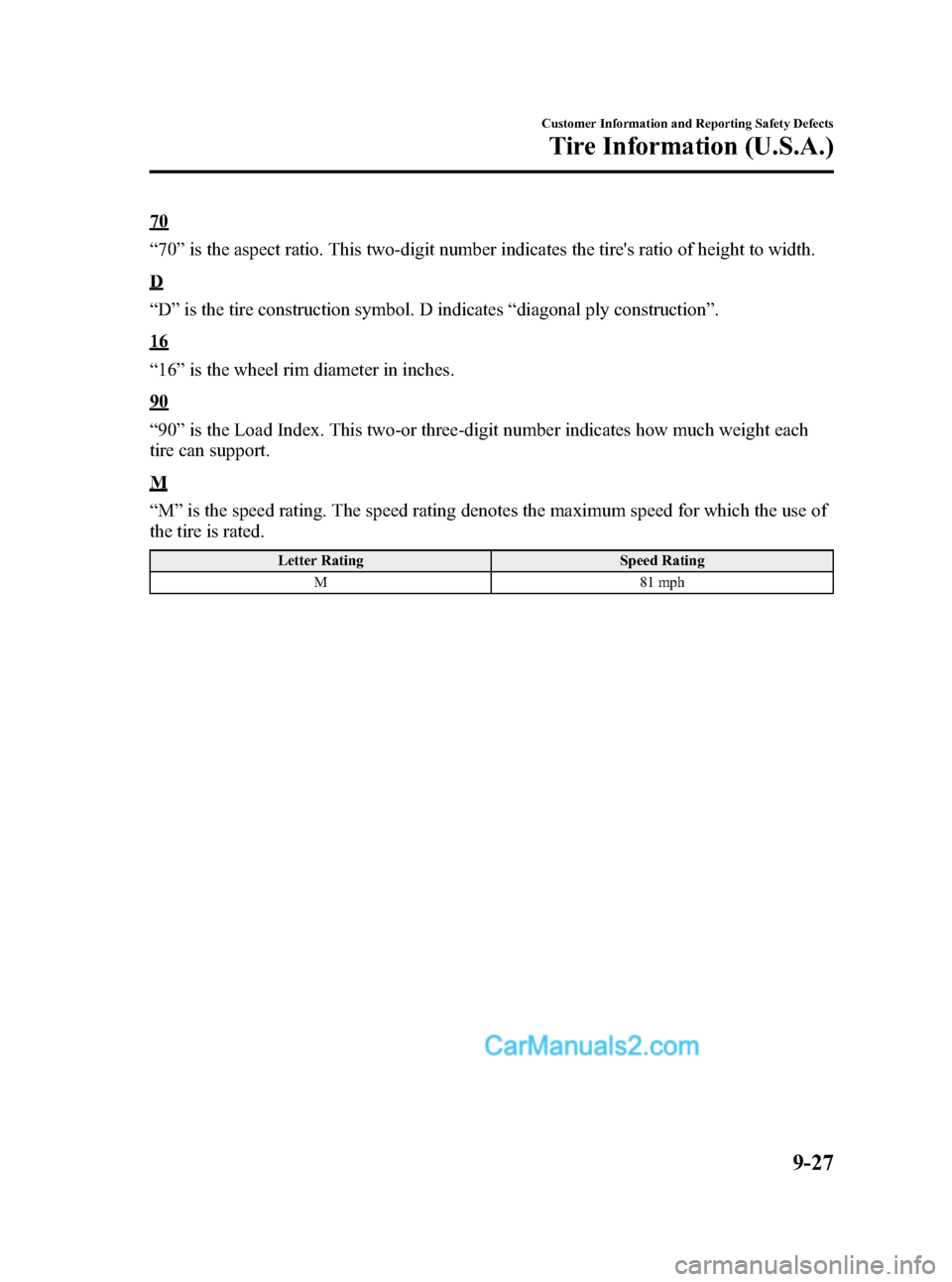
Black plate (367,1)
70
“70”is the aspect ratio. This two-digit number indicates the tire's ratio of height to width.
D
“D”is the tire construction symbol. D indicates“diagonal ply construction”.
16
“16”is the wheel rim diameter in inches.
90
“90”is the Load Index. This two-or three-digit number indicates how much weight each
tire can support.
M
“M”is the speed rating. The speed rating denotes the maximum speed for which the use of
the tire is rated.
Letter Rating Speed Rating
M 81 mph
Customer Information and Reporting Safety Defects
Tire Information (U.S.A.)
9-27
Mazda3_8V66-EA-06F_Edition3 Page367
Wednesday, August 23 2006 11:22 AM
Form No.8V66-EA-06F
Page 390 of 402
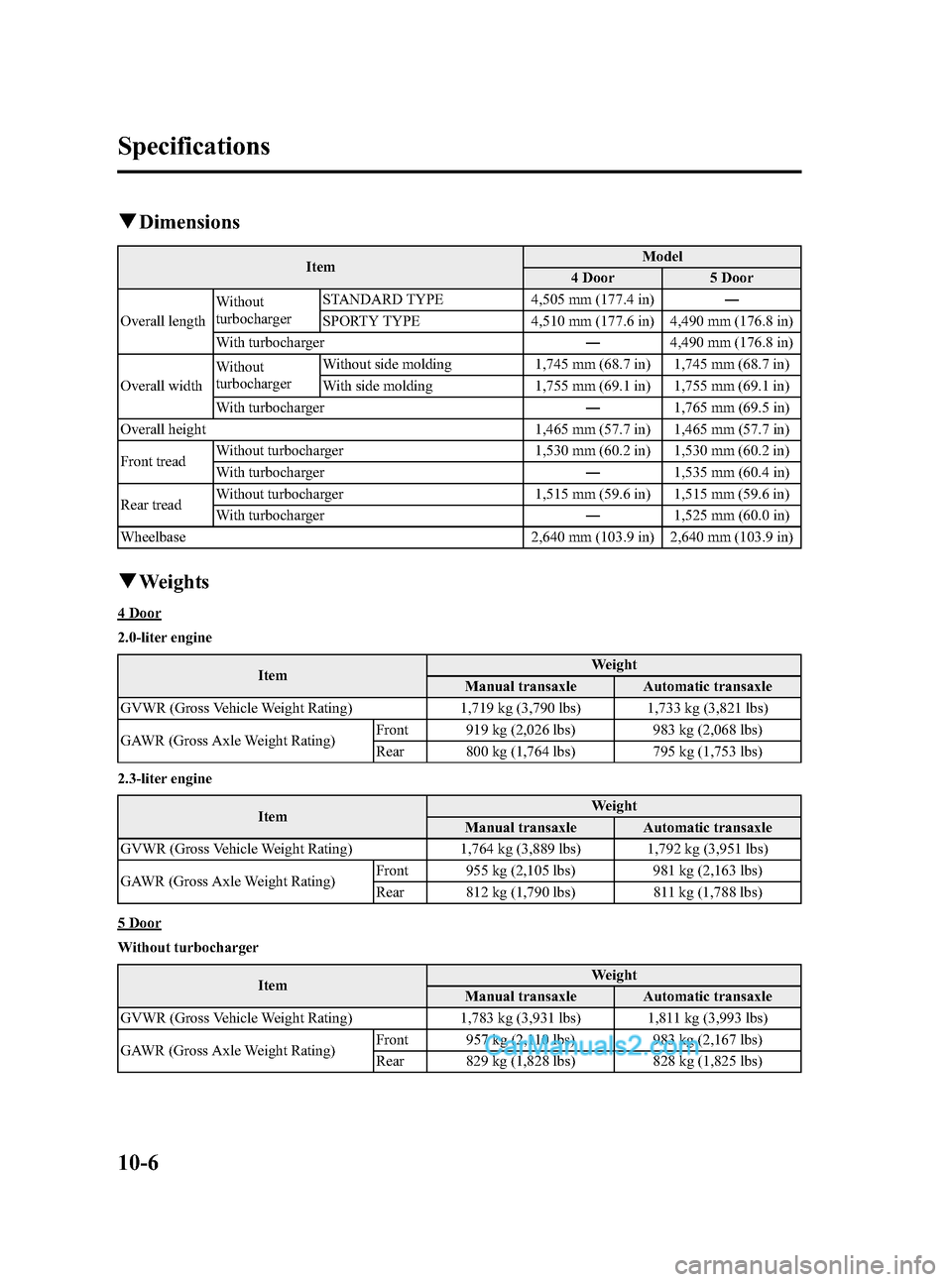
Black plate (390,1)
qDimensions
ItemModel
4 Door 5 Door
Overall lengthWithout
turbochargerSTANDARD TYPE 4,505 mm (177.4 in)―
SPORTY TYPE 4,510 mm (177.6 in) 4,490 mm (176.8 in)
With turbocharger―4,490 mm (176.8 in)
Overall widthWithout
turbochargerWithout side molding 1,745 mm (68.7 in) 1,745 mm (68.7 in)
With side molding 1,755 mm (69.1 in) 1,755 mm (69.1 in)
With turbocharger―1,765 mm (69.5 in)
Overall height 1,465 mm (57.7 in) 1,465 mm (57.7 in)
Front treadWithout turbocharger 1,530 mm (60.2 in) 1,530 mm (60.2 in)
With turbocharger―1,535 mm (60.4 in)
Rear treadWithout turbocharger 1,515 mm (59.6 in) 1,515 mm (59.6 in)
With turbocharger―1,525 mm (60.0 in)
Wheelbase 2,640 mm (103.9 in) 2,640 mm (103.9 in)
qWeights
4 Door
2.0-liter engine
ItemWeight
Manual transaxle Automatic transaxle
GVWR (Gross Vehicle Weight Rating) 1,719 kg (3,790 lbs) 1,733 kg (3,821 lbs)
GAWR (Gross Axle Weight Rating)Front 919 kg (2,026 lbs) 983 kg (2,068 lbs)
Rear 800 kg (1,764 lbs) 795 kg (1,753 lbs)
2.3-liter engine
ItemWeight
Manual transaxle Automatic transaxle
GVWR (Gross Vehicle Weight Rating) 1,764 kg (3,889 lbs) 1,792 kg (3,951 lbs)
GAWR (Gross Axle Weight Rating)Front 955 kg (2,105 lbs) 981 kg (2,163 lbs)
Rear 812 kg (1,790 lbs) 811 kg (1,788 lbs)
5 Door
Without turbocharger
ItemWeight
Manual transaxle Automatic transaxle
GVWR (Gross Vehicle Weight Rating) 1,783 kg (3,931 lbs) 1,811 kg (3,993 lbs)
GAWR (Gross Axle Weight Rating)Front 957 kg (2,110 lbs) 983 kg (2,167 lbs)
Rear 829 kg (1,828 lbs) 828 kg (1,825 lbs)
10-6
Specifications
Mazda3_8V66-EA-06F_Edition3 Page390
Wednesday, August 23 2006 11:22 AM
Form No.8V66-EA-06F